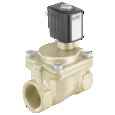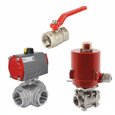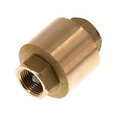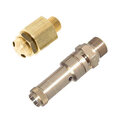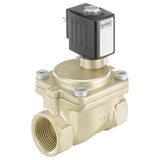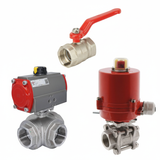Understanding Steam Valves
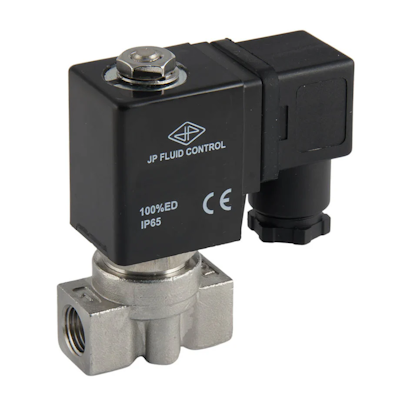
Figure 1: Stainless steel solenoid valve for steam
Steam valves regulate a system's steam flow, pressure, and temperature. Unlike standard valves that primarily control the flow of liquids or gasses, steam valves must handle the unique properties of steam, which include high temperature and pressure. These valves are critical in energy production, chemical manufacturing, and food processing industries. This article examines the features and types of valves used in steam applications.
Table of contents
- Steam in industries
- What is a steam valve used for?
- Materials for steam valves
- Steam solenoid valve
- Steam ball valves
- Steam globe valves
- Steam check valves
- Angle seat valves for steam
- Pressure relief valves
- Manual vs actuated steam valves
- FAQs
View our online selection of valves for steam applications!
Steam in industries
Steam is often classified by pressure (low, medium, high) because industrial systems are typically designed to operate at specific pressures. Low and medium pressure steam is used in most general industrial applications.
Table 1: Steam pressure and temperature ranges
| Steam type | Temperature range | Pressure range |
| Low pressure | 100 𐩑C to 121 𐩑C (212 𐩑F to 250 𐩑F) | Below 1.03 bar (15 psi) |
| Medium pressure | 121 𐩑C to 204 𐩑C (250 𐩑F to 400 𐩑F) | 1.03 bar to 10.34 bar (15 psi to 150 psi) |
| High pressure | Above 204 𐩑C (400 𐩑F) | Exceeds 10.34 bar (150 psi) |
What is a steam valve used for?
Steam is essential in various industries, including power generation, petrochemicals, and food processing. Steam valves ensure that steam flows in the correct directions and at appropriate rates. The steam valve serves several crucial functions:
- Regulate the flow of hot water or steam, ensuring that pressure and temperature levels remain within suitable ranges.
- Act as a safety mechanism by automatically closing to prevent overpressure and potential damage.
- Isolate specific sections of the boiler system, which is essential for maintenance or troubleshooting activities.
- Clean industrial equipment and surfaces, requiring precise control to ensure effective sanitation.
A good steam valve should typically handle temperatures up to 200 𐩑C (392 𐩑F) for most industrial process applications. Also, installing Y-strainers and steam drip lines to trap impurities and remove condensate from steam lines is advisable.
Materials for steam valves
The suitability of a valve for steam depends on its housing and seal materials.
- Housing materials like stainless steel (316 and 304), cast iron GGG40, and red brass can withstand the high temperatures and steam pressures.
- Seal materials like silicon, PTFE (Teflon), and EPDM are suitable for steam. However, materials like FKM and NBR are not ideal.
Steam solenoid valve
A solenoid valve for steam (Figure 1) is an electrically operated valve. It consists of a solenoid coil and a plunger. The plunger moves in response to the magnetic field generated when the coil is energized. This movement opens or closes an orifice, regulating the steam flow. They offer precise, remote, and automatic control for efficient steam system management.
Solenoid valves require clean media to function properly. Contaminants like dirt and debris can cause blockages, wear, and operational failures. Using filters or strainers upstream of the valve helps maintain clean media and ensure reliable operation.
Steam ball valves
Ball valves are shutoff valves used in steam applications requiring a straight-through flow. They are durable, provide a tight seal, and can handle high temperatures and pressures of steam. However, they may not be ideal for precise flow control.
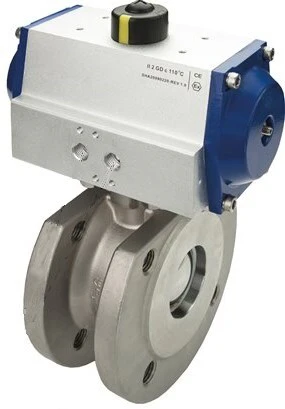
Figure 2: Pneumatic flanged ball valve for steam
Steam globe valves
Globe valves offer precise flow control, allowing fine adjustments to steam flow, which is crucial in systems requiring regular modulation. They ensure a tight seal when closed, critical for stopping flow during maintenance or emergencies on steam lines. However, more force is required to operate globe valves. Also, they can cause a higher pressure drop due to the steam's flow path through the valve.
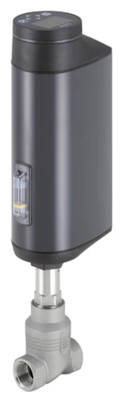
Figure 3: Burkert 3361 electric globe valve
Steam check valves
Check valves prevent backflow in steam pipelines, ensuring that steam flows in only one direction. By allowing steam to flow in only one direction, these valves protect equipment from damage and maintain process integrity. Spring and lift check valves are commonly used for steam applications. Read our check valves for steam article for more information.
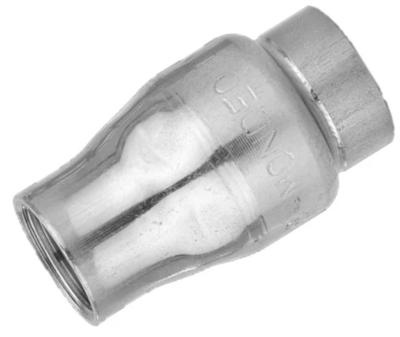
Figure 4: Stainless steel steam check valve
Angle seat valves for steam
Angle seat valves regulate the steam flow in high-temperature and high-viscosity environments. They offer minimal pressure loss and are durable in harsh environments. However, a stronger return spring may be needed to counteract the reduced working pressure caused by water hammer. Consequently, a larger actuator is required to handle the increased spring force.

Figure 5: Burkert 3320 stainless steel angle seat valve
Pressure relief valves
A pressure relief valve for steam is a safety device to protect steam systems from overpressure conditions. It automatically releases steam when the pressure within the system exceeds a predetermined set point, preventing potential damage to equipment, piping, and other components.
The pressure relief valve comes in a stainless steel housing and PTFE (Teflon)/FKM seal. The suitability of the pressure relief valve for steam depends on its seal material. Choose the relief valve with Teflon seal for steam applications.
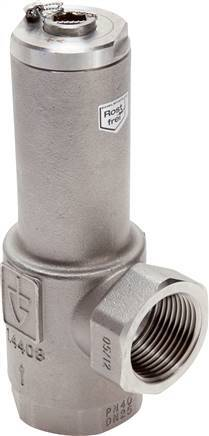
Figure 6: Stainless steel pressure relief valve for steam
Manual vs actuated steam valves
Flow control or shutoff valves for steam can be operated manually, electronically, or pneumatically.
-
Manual: Manual valves are best for applications where infrequent operation is required and cost is a concern. They are simple and reliable but require manual intervention.
- For example, manual globe valves are used to isolate steam system sections in smaller industrial facilities or during maintenance.
- Electric: Electric valves are ideal for precise control and automation applications. They allow remote operation and integration with control systems, making them suitable for complex processes. However, they can be slow compared to pneumatic valves.
- Pneumatic: Pneumatic valves use compressed air to actuate a steam valve. They are common in applications where quick response times are critical.
FAQs
What are steam valves?
Steam valves are devices designed to regulate the flow, pressure, and temperature of steam within a system, accommodating its high temperature and pressure characteristics.
Where are steam rated ball valves used?
Steam rated ball valves are commonly used in general-purpose steam distribution systems, low to medium-pressure boiler systems, and industrial processes where steam is used for heating.
What materials are in a steam valve?
The housing is made of durable materials like stainless steel and cast iron. The seal is typically made of Teflon, silicone, or EPDM.




